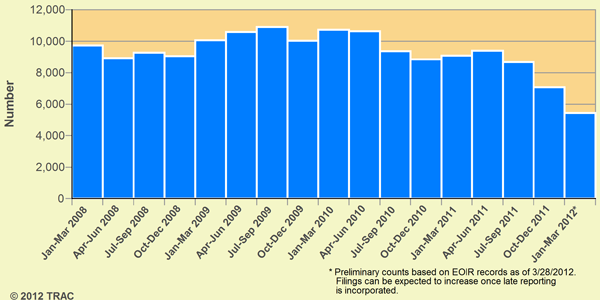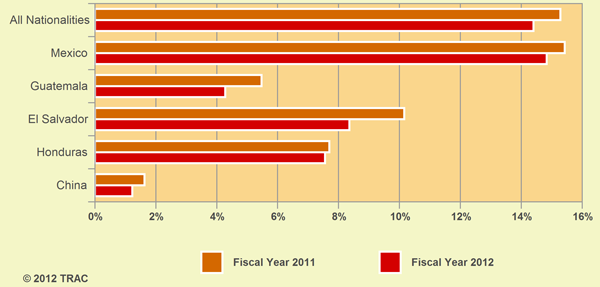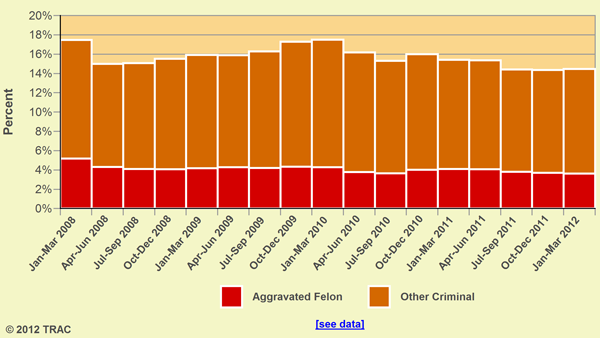Immigration and Customs Enforcement (ICE) is identifying fewer individuals as deportable owing to alleged criminal activity[1], according to the latest Immigration Court data on new deportation proceedings. During the most recent quarter (January - March 2012), ICE sought to deport a total of 5,450 individuals on criminal grounds. While this number is preliminary and is likely to increase once late reports are in, it represents a drastic decrease compared with 10,732 individuals against whom ICE sought deportation orders just two years ago (during the period January - March 2010). See Figure 1 and Table 1.

|
Table 1. Deportation Orders Sought in Immigration Court Based on Alleged Criminal Activity
|
|||||||||||||||||||||||||||||||||||||||||||||||||||||||||||||||||||||||||||
Court filings began dropping even before ICE Director John Morton issued his June 17, 2011 directive on prosecutorial discretion (PD), which outlined the manner in which enforcement activity could be focused on deporting serious criminals. Since that announcement, however, official court records show that rather than increasing, the number of deportations ordered on the basis of criminal activity has continued to decrease. Evidence from the most recent quarter show that the agency continues to be headed in the opposite direction from its stated goal. See Table 1.
The decline in the number of individuals charged with being deportable for criminal activity has been more rapid than the overall decline in court filings over the last two years. This means that those targeted on the basis of criminal grounds are not simply fewer in number, but they also make up a declining proportion of all Immigration Court cases. Quarterly trends over the past four years are shown in Figure 2.
The colored bars in Figure 2 divide alleged criminal activity into two types. The proportion ICE claims are deportable as convicted "aggravated felons" are indicated by the lower red bars, while the upper brown bars represent the proportion alleged to have engaged in other criminal activity. A downward trend can be seen for both types, in absolute numbers and also when considered as a percentage of all deportation proceedings (see supporting data for Figure 2).
All of the above results are based upon analyses by the Transactional Records Access Clearinghouse (TRAC) at Syracuse University of case-by-case records covering all proceedings filed in the Immigration Courts. These records were obtained by TRAC under the Freedom of Information Act (FOIA) from the Executive Office for Immigration Review (EOIR). EOIR is the part of the Department of Justice which administers the nation's special administrative court system charged with deciding whether noncitizens should be deported or are legally entitled to remain in the country[2].
See also TRAC's previous report tracking the basis for deportation proceedings for the decade before 9/11 with the decade after 9/11, and contrasting Bush and Obama administration records.
Targeting Trends by Nationality
|
Table 2. Deportation Orders Sought in Immigration Court Based on Alleged Criminal Activity by Nationality
|
In the most recent quarter, just five countries — Mexico, Guatemala, El Salvador, Honduras and China — accounted for nearly four out of five (79 percent) of all new cases in Immigration Court. Of these, in FY 2011 Mexico had the highest proportion of those ICE sought to deport on criminal grounds (15.4 percent) and China the lowest (1.6 percent). In both cases, ICE cited criminal grounds less frequently during the first six months of FY 2012: for Mexico it declined to from 15.4 to 14.8 percent; for China it fell from 1.6 to 1.2 percent. See Table 2 and Figure 3.
|
Figure 3. Decline in the Proportion of Deportation Orders Sought
in Immigration Court Based on Alleged Criminal Activity 
|
In FY 2011, the rates at which individuals from El Salvador, Honduras and Guatemala were charged with being deportable for criminal activity — 10.2, 7.7 and 5.5 percent, respectively — were intermediate between those for Mexico and China. But again, for all three countries ICE sought fewer deportations of individuals charged with engaging in criminal activity during the first six months of FY 2012.
Specific details and trends for all nationalities (including these five) are available using TRAC's Immigration Court deportation proceedings tool which has been updated with data through March of 2012.
In addition to these overall trends, the deportation proceedings tool also allows the details for each nationality to be examined by Immigration Court and hearing location.
[1] References to criminal activity are for only those deportation order requests in which ICE cites such activity as at least one of its bases. ICE may choose to use other grounds in seeking the deporting of individuals with criminal convictions, but the number cannot be determined due to ICE's withholding of data on deportation orders.
[2] We used the term "deportation" in a generic sense — whether legally labeled as removal, deportation, or expulsion based upon inadmissibility grounds.
